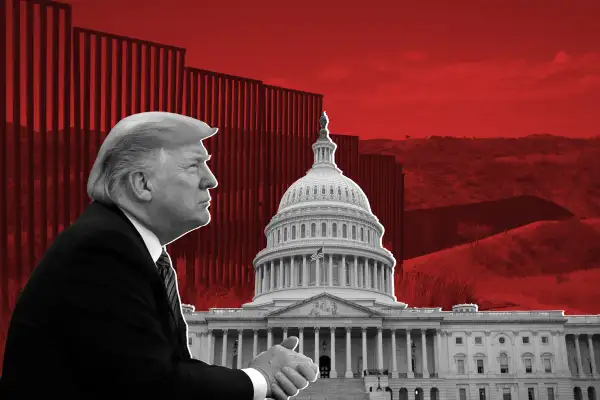The Government Shutdown Will Cost More Than Trump's $5 Billion Border Wall Funding, According to Experts

The economic costs of the government shutdown may already exceed the $5 billion President Donald Trump is demanding for a border wall, according to some analysts' estimates.
The federal government partially shut down two weeks ago when the Senate failed to pass a spending bill that included the border wall funding, beginning a standoff that has carried into the new year.
Nine out of 15 federal departments, along with dozens of agencies and federal programs, have closed or reduced services. Roughly 800,000 federal employees are affected, either because they have been directed to stay home without pay or because they are working but not receiving paychecks during the shutdown.
Some taxpayers may think this isn't such a bad thing. The drop in payroll and the decrease in government services would mean less taxpayer money spent, right? Actually, no. The truth is that the ongoing partial government shutdown is costing American taxpayers and the U.S. economy overall billions of dollars.
How Much a Government Shutdown Costs
Referring to a 2013 shutdown that lasted 16 days, Rand Paul, the Republican U.S. Senator from Kentucky, said it "cost us more to shut the government down than to keep it open"—a statement that Politifact rated as true.
How could this be? First off, federal workers who are not paid during a government shutdown typically receive back pay once the shutdown is over, whether or not they were furloughed. So there is no money "saved" through a drop in federal employment payroll.
"We are paying people to do nothing," Gordon Gray, director of fiscal policy of the center-right advocacy group American Action Forum, said to Money. "That's basically pure waste. It's one way that the federal government is basically taking money and throwing it out the window."
In an analysis published this week, Gray wrote that "government shutdowns impose costs through three channels: federal budgetary costs, forgone services, and, last and most amorphous, economic disruption."
The budgetary costs include wages going to federal workers who aren't working and other smaller factors, such as resources spent shutting down offices rather than getting work done. "Think of it as similar to the costs of locking up the store before closing," Gray said. Foregone services include things like permits and fees which the government cannot collect during a shutdown and therefore amount to lost revenues.
Then there is the impact of government shutdowns on the economy as a whole. In the official Office of Management and Budget (OMB) analysis of the October 2013 government shutdown, which lasted 16 days, researchers estimated that the shutdown lowered real GDP growth by 0.2% to 0.6%. That amounted to somewhere between $2 billion and $6 billion in lost economic output.
The American Action Forum's Gray told Money that the costs of the current shutdown are already likely on par with those of the 2013 government shutdown. While the current partial shutdown is smaller in scope than the 2013 shutdown, "the economy is bigger, and the government is bigger" today, Gray said. The present-day shutdown over border wall funding has easily "cost America a couple or a handful of billion dollars," he said.
In other words, the costs of the partial government shutdown may already exceed the $4 billion to $5 billion in additional funding that Congress and President Trump are negotiating over.
Why the Government Shutdown May Cost Tens of Billions More
By the time the government shutdown is over, the impact on the economy may make $5 billion seem like peanuts. For one thing, there's no end in sight. Even though the House Democrats plan to pass a plan reopening the government without funding for the border wall, Trump has said the shutdown will last "as long as it takes" for Congress to allocate the additional billions for the wall. So the government shutdown may last for quite some time.
What's more, compared to some other research on government shutdowns, the 2013 OMB report may significantly underestimate the costs of that year's 16-day shutdown. Standard & Poor's estimated that the costs of the 2013 government shutdown actually came to $24 billion after incorporating the impact of the shutdown on hard-to-pin-down factors like decreased consumer and investor confidence — components that aren't tabulated in the OMB analysis.
As another example, in late 2017, Standard & Poor's analysts said that a government shutdown threatened at the time would cost the American economy roughly $6.5 billion per week.
William G. Gale, a senior fellow for the nonpartisan Brookings Institution think tank, wrote this week that the shutdown is especially silly because the amount of money being fought over is tiny in the grand scheme. "The programs without current funding cost more than $300 billion per year," Gale wrote. "By contrast, the amount in dispute regarding the wall is roughly $4 billion, after accounting for more than $1 billion of border security funding previously offered by Democrats."
"The notion that much of the government should shut down because of disagreements in one tiny area of government spending defies logic and common sense. No business would operate that way," Gale wrote. "While the political grandstanding continues, the economy will suffer."
Have your finances or daily life been affected by the government shutdown? We want to hear your story. Email us at money_letters@moneymail.com or tell us how in the comments below.
